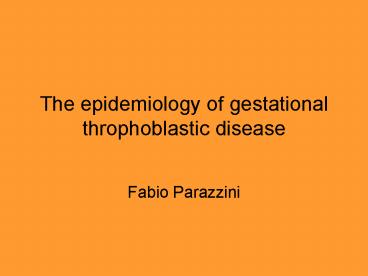The epidemiology of gestational throphoblastic disease - PowerPoint PPT Presentation
1 / 21
Title:
The epidemiology of gestational throphoblastic disease
Description:
Few data are available from epidemiological studies ... noma. PHM. CHM. Class age. Paternal age. History of GTD and reproductive factors ... – PowerPoint PPT presentation
Number of Views:78
Avg rating:3.0/5.0
Title: The epidemiology of gestational throphoblastic disease
1
The epidemiology of gestational throphoblastic
disease
- Fabio Parazzini
2
Summary
- Frequency
- Geographical differencies
- Time trends
- Risk factors
3
Incidence of HM/100000 pregnancies selected
studies
4
CHM vs PHM
- Few data are available from epidemiological
studies - In a study in Danmark the rate of CHM was
80/100000 and of PHM 39/100000 - In the French registry 2 out of 3 HM were CHM
(Golfier et al, AJOG, 2007) - In the French study PHM were reclassified in the
25 of cases.
5
Incidence of choriocarcinoma/100000 pregnancies
selected studies
6
Age standardized incidence rates of
choriocarcinoma/100000 donne
7
Methodological problems
- Cases identified through hospital pathology
records - Selection
- Confoundings are not taken into account
8
Time trends
9
Trends in migrants
- In a study conducted in the New Mexico the rate
of GTD decreased of about 40 in white and 62 in
other races (not black) (Smith et al, 2006) - No data are available from European countries
10
Risk factors
- Parental age
- History
- Reproductive factors
- Oral contraceptives use
- Miscellanea
11
Maternal age OR (reference category 20-35)
12
Paternal age
13
History of GTD and reproductive factors
- In women with previous GTD the risk of recurrent
GTD is about 20-40 times higher (Di Cintio et al,
1997, BerMac Gregor et al, 1969) - Previous term births are associated with a
decreased risk OR 0.4-0.8(Di Cintio et al, 1997,
La Vecchia et al, 1985 Parazzini et al, 1991) - Previous spontaneous abortions are associated
with an increased risk OR 1.2-1.4 (Di Cintio et
al, 1997, La Vecchia et al, 1985 Parazzini et
al, 1991)
14
Oral contraceptives
- Some studies have suggested an increased risk of
PTD/choriocarcinoma after the evacuation of a HM,
but the data are not consistent (Bagshawe and
Lawler, 1982,Mallon and Modan , 1972) - Ever OC use has been related with the risk of HM
(Altieri et al, 2007)
15
OC and risk of GTD
16
Blood groups
- Women with blood groups A and AB have an
higher risk(OR about 1.5-2.0) than women with
group O and B
17
ABO blood groups
18
Other factors
- Infection
- a role of infection has been suggested , but
epidemiological data are controversial - Smoking
- possible risk factor OR about 1.5-2.0
- (La Vecchia et al, 1985, Di Cintio et al,
1997) - Diet/Social class
- the highest rates of GTD in women of lower
social class in less developed countries may be
explained by low protein intake.
19
Molar pregnancy and childhood cancer
20
Conclusions frequency
- In North America and Euope the rates are about
10/100000 pregnancies - PM are about 1 out of 3 molar pregancies
- Choriocarcinomas are about 1 out of 20-30 molar
pregnancies - Higher rates are observed in some areas of Asia
and Middle East - Chorioarcinoma shows similar geographical
differencies - The differencies seem to lower during time
21
Conclusions risk factors
- Age is the main determinant in particular for CHM
- A previous history is another strong risk factor
- Other factors include repoductive history
maternal blood groups, OC use, diet and infection - The relation between mole and childohood cancers
needs further studies































